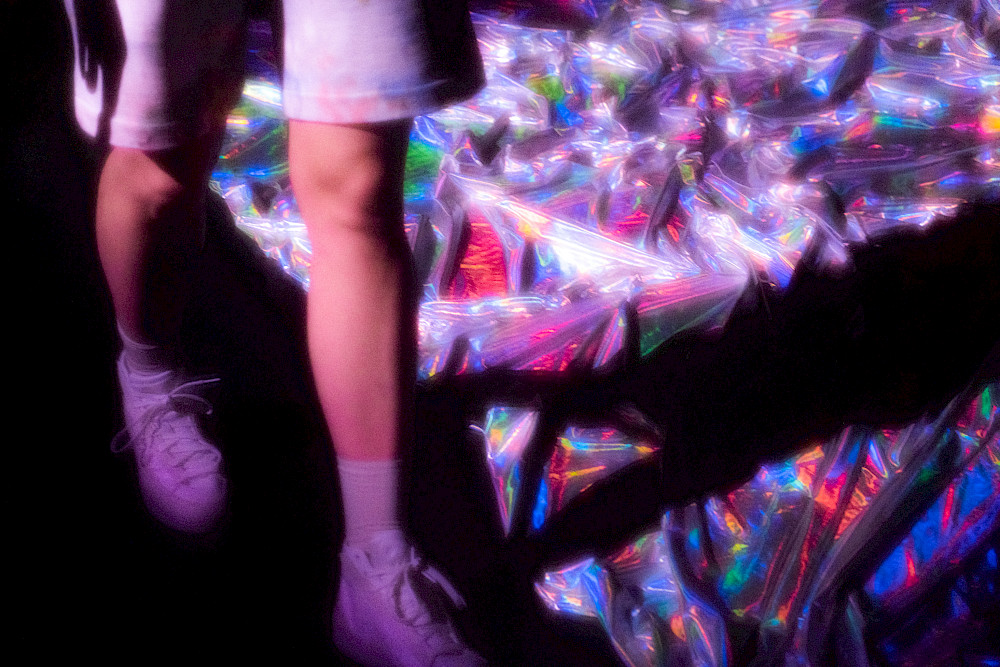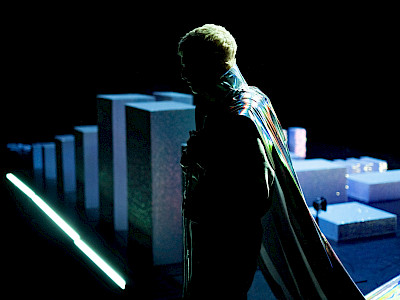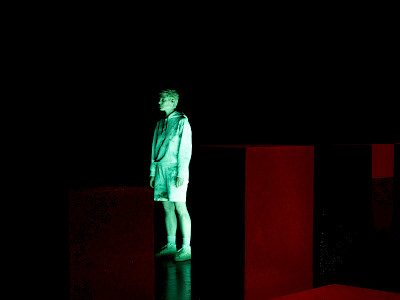18 — 21.05.2023
How are children considered and approached by the institutions responsible for protecting and educating them? What frameworks surround children, and how can we redefine these frameworks, adjusting them to fit the worlds that children invent for themselves in order to survive? Director and performer Léa Drouet moves from one story to another within a stage setting of shimmering, multipurpose fabrics, covering hybrid shapes representing sometimes a landscape, then a hut, a school or a town. Various incidents involving children or young people, and especially their treatment by the media, the police and the law, are combined with stories of monsters and bravery, inspired by those which Léa and her daughter tell each other in shared moments. Rather than “looking at the children”, Drouet is seeking to “look at how we look at children”. She probes the mechanisms of education and the tension between ‘upbringing’, ‘punishment’ and ‘repression’ inherent to our society and the ‘dutiful citizens’ it produces. After Violences – shown at Kunstenfestivaldesarts 2021 – Léa Drouet is moving deeper into her investigations of childhood, the imaging which stifles it, and conversely, the imaging which gives it room to move and breathe.
J’ai une épée
Interview with Léa Drouet and Camille Louis
Sylvia Botella – After Violences, which was performed at the Kunstenfestivaldesarts in 2021, J’ai une épée adopts a balanced, more tailored approach to childhood, avoiding categorisations and “sad stories”, such as “the child who needs saving” or “the child who needs to be improved, educated or trained”. How have you managed it?
Léa Drouet – Talking about “the child” can in itself confine him or her to one of those “sad stories”. The label is performative: it does something, it has an effect on the world. Even though childhood persists, we preserve this time in our lives from birth to puberty. We put it outside of ourselves. We make it something “separate”. But in J’ai une épée, when it comes to “the child” we don’t freeze the image. By examining the institutions involved in welcoming or educating children, we avoid making childhood a case study. The image is always moving.
Camille Louis – In fact the institutions around childhood target and identify exactly what it is, fixing its beginning and end. So what are the effects of this? We’re not analysing or interpreting its damaging effects or objectifying “the child” in some way. The aim of our research is to look at what childhood makes us do. What does it refer to? In this sense, the big question is how children affect and shake up the institutional framework today. My feeling is that the essence of our work is about maintaining the tension that exists between the mechanisms of institutional violence and what children make up to deal with it, individually and collectively. So we attach a lot of importance to places where things are going awry and are a bit shaky. We’re very keen not to turn children into heroes or dispensers of justice. It’s more a case of how they get by.
You’ve investigated several real stories involving children, through stories about monsters told by your four-and-a-half-year-old daughter, Léa, through children and above all experienced by children. Can you tell us something about this?
LD – Except for Marseille, where we met students from the Denis Diderot secondary school in the north of the city, we haven’t actually gone out into the field. There were plenty of reasons for this, but the main one was that I wanted to avoid any form of objective fixation or extractivism. In J’ai une épée, I specifically used the investigative work undertaken by the Médiapart journalist François Bonnet on several cases of children suspected of “glorifying terrorism” who were the target of police investigations. One of our areas of research is the invention of stories.
CL – This is a fundamental choice, since inventing stories starts with reality but stretches it towards what’s possible, exaggerating it in both directions. Our main field of research concerns representations. The way the media deal with facts is revealed thanks to a series of images that are produced. What are they? What do they ordinarily do to our minds? How do they form an environment? Whatever it is, we have to explore it, but in a different way.
What is your writing process? What textual body takes shape?
LD – I’ve wondered for a long time about the register of what’s said. It’s a bit like a child’s drawing. I found one of the drawings I did at nursery school: it was a very fantasised depiction of my teacher. She’s wearing a crown. It’s not unusual for children to depict figures of authority as a kindly king or queen. I have the feeling that that’s what I’m looking for when I write: a succession of memorable, talking little pictures.
CL – In a drawing, there are holes and perspectives. Léa is continuously building visual scenes made from objective and fantasised images.
LD – Drawing allows the co-existence of opposites, utopias, cruel little scenes, very different times and places. It’s probably similar in certain respects to the style of Jérôme Bosch in the fact that you’re drawing a little scene here, a little scene there, another one over there. Better still, they’re a reminder of children’s self-defence that allows them to escape their situation for just a moment using their imagination. J’ai une épée is based on an imaginary world of drawing and traces.
CL – In her writing, Léa brings together two situations and in fact a sensitive performative drawing, always seeking contradictions and complexities. Her ability to redraw tricky situations in a shiny stage design is remarkable, counter-acting expectations in a documentary fairy tale full of reliefs.
In J’ai une épée, what are the vanishing points for opening up different horizons?
CL – It’s about highlighting the need for understanding: not everything can immediately be seen. We’re looking at someone who’s looking somewhere. Except this “somewhere” seems capable of providing all the space required for the people looking and providing a critique. And above all revealing what’s possible. So we’re looking less at the child and more at what the child is looking at.
LD – The vanishing point is one of the forms of a child’s self-defence. Suddenly, the child does a drawing in the crease of the carpet or looks out the window, and so is escaping the space for a moment. These are self-defence mechanisms I sometimes use myself. I see in this the persistence of childhood into adulthood.
How do children’s worlds shake ours up?
LD – In J’ai une épée, we (re)visit contemporary scenes that put children into certain situations, while trying to maintain a part of our childhood in the way we see them. What am I summoning up from this time of our lives that persists in each and every one of us? I’d like the audience to directly experience the child’s self-defence mechanisms in stifling scenes of surveillance and punishment that can be reminiscent of the dark days of fascism. The psychoanalyst and philosopher Bertrand Ogilvie, who wrote The Golden Legend of the Emancipated School, says that we’re afraid of children because they can dismantle everything we share. In other words, children are continuously shaking up what we’ve jointly built and we think will carry on. Having childhood persist in us challenges the established order.
CL – The child continuously reminds us of the artificiality of our structures. Faced with various affectations and people banging on about there being “no alternative”, the child embodies irreverence and confidence from the outset.
- Interview conducted by Sylvia Botella for the Kunstenfestivaldesarts and the Théâtre National Wallonie-Bruxelles.
- Sylvia Botella is a dramaturge at the Théâtre National Wallonie-Bruxelles. She is also a critic and tutor on the performing arts masters course at the Université Libre de Bruxelles and on the masters in dramatic performance at the Institut des Arts de Diffusion (IAD) in Louvain-la-Neuve.
Presentation: Kunstenfestivaldesarts, Théâtre National Wallonie-Bruxelles
Direction, text and performance: Léa Drouet | Dramaturgy: Camille Louis | Set design: Élodie Dauguet | Music composition: Èlg | Lights: Nicolas Olivier | Costumes: Eugénie Poste | Technical and stage management: François Bodeux/Vaisseau | Direction assistant: Marion Menan | Technicians TNWB: Pier Gallen (technical management), Jacques Perera (lighting), Stéphanie Denoiseux (stage), Jeison Pardo (sound) | Production development and distribution: France Morin, Anna Six/Ama Brussels | A performance by Léa Drouet, Vaisseau asbl | Creation: Studio Théâtre National Wallonie-Bruxelles
Production: Théâtre National Wallonie-Bruxelles, Vaisseau asbl | Coproduction: Kunstenfestivaldesarts, Printemps des Comédiens - Montpellier, Le Phénix — Scène Nationale de Valenciennes, NEXT Arts Festival, Théâtre de Liège, Le Maillon Théâtre de Strasbourg - Scène européenne, Mars-Mons - Arts de la scène, Centre Culturel André Malraux - Scène Nationale de Vandœuvre-lès-Nancy, La Coop asbl, Shelter Prod
With the support of: La Fédération Wallonie-Bruxelles, Service Général de la Création Artistique - Direction du Théâtre, Kunstencentrum BUDA, La Bellone House of Performing Arts, Taxshelter.be, ING and the Tax Shelter of the Belgian federal government




